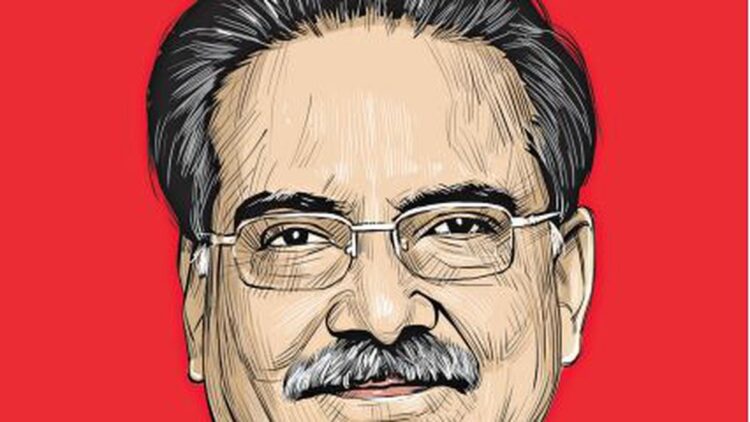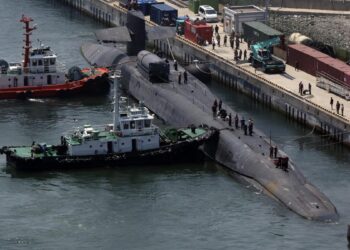[ad_1]
Pushpa Kamal Dahal has a fatal attraction with power. The chairman of the Communist Party of Nepal (Maoist-Centre) became the Prime Minister of the country, recently, for the third time after stints in 2008-09 and 2016-17. Nepal’s fragmented polity always provides for coalitions and this allows smaller parties to either become kingmakers or lend a leader to occupy the seat at Singha Durbar in Kathmandu for expedient purposes.
Except, in Mr. Dahal’s case, his party, the CPN (M-C), was part of a pre-poll six-party coalition led by the Nepali Congress (NC), which won just about an absolute majority in the parliamentary elections held in November 2022. But it but saw it fit to quit the coalition after the polls and firmed up a post-poll alliance with the leading Opposition party, the Communist Party of Nepal (Unified Marxist-Leninist, or UML), led by Khadga Prasad Oli and six other parties, and secured the coveted Prime Minister’s post for a prospective period of half the term of government.
Observers following Nepali politics would not be surprised at the malleable nature of the political alliances in the country. Ever since Nepal transited from a constitutional monarchy to a constitutional republic in 2008, the three leading political forces — the social democratic-oriented but centrist NC, the purportedly leftist but status-quoist on principle UML and the historically leftist CPN (M-C) — have been arranging the decks of government among themselves and other smaller partners. In fact, the UML-CPN(M-C)’s sudden marriage of convenience is a throwback to the previous elections in 2017 when both parties (which also included a UML faction led by former Prime Ministers Madhav Nepal and Jhalanath Khanal) had formed the government with a commitment to merge into a single Nepal Communist Party.Much water has flowed through the Bagmati river since then with Mr. Oli’s refusal to hand over power to Mr. Dahal in 2020 being one of the key reasons for the breakdown of the NCP into its former constituent units, besides Mr. Dahal’s party and Mr. Nepal’s UML faction — later christened as Communist Party of Nepal (Unified-Socialist) — finding common cause with the NC purportedly as a check against Mr. Oli’s authoritarian tendencies.
Yet, despite the ever present flux in party alignment and coalition formation, the fact that Mr. Dahal went on to become the PM despite his party’s dismal showing in the parliamentary elections — it finished a distant third with a total of 32 seats in the House of Representatives with just 11.32% of the vote — is seen as the latest example of political opportunism by a leader who has come a long way from being a revolutionary militant leader set on changing the political and ideological structures of Nepal to becoming one of the Kathmandu power elite wedded to the status quo.
Born in a poor Bahun (Khas or hill Brahmin) family in Kaski district to the west of Kathmandu in 1954, Mr. Dahal went on to pursue higher education in a three-year degree programme in agriculture and animal science and became a schoolteacher in Gorkha district. He had been attracted to communist ideas by then and soon quit his teaching post to become a full member of the Communist Party of Nepal (Fourth Convention) — then a major clandestine communist force that was founded by the radical leader Mohan Bikram Singh — before taking up an office-bearer’s position with Mr. Singh’s breakaway Communist Party of Nepal (Masal). In quick time, Mr. Dahal, then known by the nom de guerre “Biswas” (or trust), was elected to the party’s central committee in 1984. The Masal group split further, with Mr. Dahal joining hands with another radical leader Mohan Baidya to form a new party, CPN(Mashal) while Mr. Singh retained control over CPN(Masal).
The Mashal group went on to term themselves as a party aligned with Marxism-Leninism-Maoism, essentially committing itself to the prospects of militant struggle and organising the peasantry to gain power in the rural areas and using them to to encircle the cities and capture power. It had in the mid-1980s already become part of the clandestine Revolutionary Internationalist Movement — the ideological group of like-minded Maoist parties which included the Shining Path of Peru. In 1986, a violent action by the Mashal group brought it under the scanner of the Nepal police and led to the arrest of its party cadre, with the fallout leading to the resignation of Mr. Baidya from the leadership of the party and the elevation of Mr. Dahal as the general secretary. Mr. Dahal reportedly underwent training in guerilla warfare in India in the late 1980s with help from the Maoist Communist Centre, then in undivided Bihar (the MCC was later to merge with the People’s War group to form the CPI (Maoist) in 2004).
Unity Centre
The radical left Mashal group later merged with other like-minded parties to form the CPN (Unity Center), which underwent further splits to emerge as the Communist Party of Nepal (Maoist) in 1994 led by Mr. Dahal and including other leaders such as future Prime Minister Baburam Bhattarai. The Maoists, unlike the UML and the NC, had not accepted the constitutional monarchy order that had been arrived at after the first Jan Andolan in 1990 and resulted in then king Birendra giving up on absolute monarchy and restoring the parliamentary party system.
After submitting a charter of demands seeking the overhaul of the constitutional order with the monarchy at the apex and the need for an elected Constituent Assembly — which were not paid heed to by the then Government — the Maoists embarked upon armed struggle in 1996 by focusing on guerilla actions in the remote western parts of Nepal in particular. Mr. Dahal, who by that time went by the name ‘Prachanda’ (the valiant), consolidated his control over the organisation, while his comrades in arms, Bhattarai ‘Laldwaj’ and Baidya ‘Kiran’, took up the initiative of being the face of the United Front and the ideological figurehead. By concerted militant actions targeting the police in remote districts and by utilising the political differences between the palace and the democratic establishment, the Maoists were slowly able to gain control in villages in a significant number of districts — mostly in the janajati (hill indigenous people) dominated western regions between 1996 and 2001.
By articulating the demand for state restructuring to accommodate the political rights of representation for marginalised ethnic groups such as the Janajatis and the Madhesis (plain dwelling people) to be secured as federal autonomous provinces where such groups were in the majority, the Maoists broadened their support base. Under Prachanda’s leadership, the Maoists also managed to swiftly utilise the public anger against the monarchy following the Narayanhiti palace massacre in 2001. Soon the Prachanda-Baburam combine were able to convince the rest of the party/movement to consolidate the gains during the insurgency and to align with the democratic parties against the new king Gyanendra — a political strategy that led to the eight party alliance, the the Jan-Andolan-2, a comprehensive peace accord and later the deposing of the monarch and the concession of the demand for a Constituent Assembly.
Mr. Dahal and the rest of the Maoist leadership — except for those leading the United Front were mostly living underground — were based in India during the most part of the insurgency.
Face of the party
After the peace accord, Mr. Dahal became the face of the party during the elections after which the Maoists emerged as the single largest party, to the surprise of observers. Mr. Dahal became the first Prime Minister of republican Nepal in 2008, but his tenure was cut short after his attempts to replace the then army chief Rupmankad Katwal, just months before his retirement resulted in the break-up of the coalition that led the government and his resignation.
The Maoists soon lost the upper hand despite being the single largest party as differences within the party emerged on the strategy that they had adopted. Hardliners such as Mr. Baidya later split from the party even as Mr. Dahal was accused of amassing wealth and living a typical Kathmandu elite politician’s lifestyle and being enmeshed in the darbari culture — a far cut away from the revolutionary ethos that he had espoused during the insurgency.
The Maoists faced a setback in the 2013 elections despite vociferously supporting the demand for comprehensive federal restructuring — they finished third behind the NC and the UML. By 2015, the Constituent Assembly managed to finalise a new constitution, which fell short of expectations of the Madhesis in particular and thanks to Mr. Dahal’s sudden change of stance, the demand for comprehensive federalisation remained unfulfilled. Mr. Bhattarai was the next Maoist leader to split from the party, forming a new one that aligned with other Madhesi parties, even as Mr. Dahal utilised differences between the UML and the NC to become the PM once again in 2016 for nearly a year. Sensing the political mood and the decline in the fortunes of the Maoists, Mr. Dahal entered in alliance with Mr Oli and soon sought a merger of the Maoists with the UML in 2017, only for the left alliance to come apart later.
The Maoists led by Mr. Dahal are now a rudderless force in terms of ideology — they still proffer token revolutionary goals but are unclear of how they seek to achieve it using the multi-party system. Unlike the NC, the Maoists have not instituted internal democratic reforms and Mr. Dahal leads by fiat. His attempts at bringing together the disparate ex-rebels back to the fold have largely been a failure with only Mr Bhattarai’s party being part of the six-party alliance in 2022.As PM, Mr. Dahal now leads a disparate coalition that includes a powerful UML led by Mr. Oli, who pulls the strings of power, an avowed anti-federal party in the newcomer Rastriya Swatantara Party, the former royalist Rashtriya Prajatantra Party among others. The only glue that seems to hold this coalition together seems to be a thirst for power and the need to use it to foster patronage for leaders of respective parties. As things stand, Mr. Dahal’s task remains cut out to arrest the decline of his party as an ideological force and its hold on its dwindling support base.
[ad_2]
[ad_1]
Pushpa Kamal Dahal has a fatal attraction with power. The chairman of the Communist Party of Nepal (Maoist-Centre) became the Prime Minister of the country, recently, for the third time after stints in 2008-09 and 2016-17. Nepal’s fragmented polity always provides for coalitions and this allows smaller parties to either become kingmakers or lend a leader to occupy the seat at Singha Durbar in Kathmandu for expedient purposes.
Except, in Mr. Dahal’s case, his party, the CPN (M-C), was part of a pre-poll six-party coalition led by the Nepali Congress (NC), which won just about an absolute majority in the parliamentary elections held in November 2022. But it but saw it fit to quit the coalition after the polls and firmed up a post-poll alliance with the leading Opposition party, the Communist Party of Nepal (Unified Marxist-Leninist, or UML), led by Khadga Prasad Oli and six other parties, and secured the coveted Prime Minister’s post for a prospective period of half the term of government.
Observers following Nepali politics would not be surprised at the malleable nature of the political alliances in the country. Ever since Nepal transited from a constitutional monarchy to a constitutional republic in 2008, the three leading political forces — the social democratic-oriented but centrist NC, the purportedly leftist but status-quoist on principle UML and the historically leftist CPN (M-C) — have been arranging the decks of government among themselves and other smaller partners. In fact, the UML-CPN(M-C)’s sudden marriage of convenience is a throwback to the previous elections in 2017 when both parties (which also included a UML faction led by former Prime Ministers Madhav Nepal and Jhalanath Khanal) had formed the government with a commitment to merge into a single Nepal Communist Party.Much water has flowed through the Bagmati river since then with Mr. Oli’s refusal to hand over power to Mr. Dahal in 2020 being one of the key reasons for the breakdown of the NCP into its former constituent units, besides Mr. Dahal’s party and Mr. Nepal’s UML faction — later christened as Communist Party of Nepal (Unified-Socialist) — finding common cause with the NC purportedly as a check against Mr. Oli’s authoritarian tendencies.
Yet, despite the ever present flux in party alignment and coalition formation, the fact that Mr. Dahal went on to become the PM despite his party’s dismal showing in the parliamentary elections — it finished a distant third with a total of 32 seats in the House of Representatives with just 11.32% of the vote — is seen as the latest example of political opportunism by a leader who has come a long way from being a revolutionary militant leader set on changing the political and ideological structures of Nepal to becoming one of the Kathmandu power elite wedded to the status quo.
Born in a poor Bahun (Khas or hill Brahmin) family in Kaski district to the west of Kathmandu in 1954, Mr. Dahal went on to pursue higher education in a three-year degree programme in agriculture and animal science and became a schoolteacher in Gorkha district. He had been attracted to communist ideas by then and soon quit his teaching post to become a full member of the Communist Party of Nepal (Fourth Convention) — then a major clandestine communist force that was founded by the radical leader Mohan Bikram Singh — before taking up an office-bearer’s position with Mr. Singh’s breakaway Communist Party of Nepal (Masal). In quick time, Mr. Dahal, then known by the nom de guerre “Biswas” (or trust), was elected to the party’s central committee in 1984. The Masal group split further, with Mr. Dahal joining hands with another radical leader Mohan Baidya to form a new party, CPN(Mashal) while Mr. Singh retained control over CPN(Masal).
The Mashal group went on to term themselves as a party aligned with Marxism-Leninism-Maoism, essentially committing itself to the prospects of militant struggle and organising the peasantry to gain power in the rural areas and using them to to encircle the cities and capture power. It had in the mid-1980s already become part of the clandestine Revolutionary Internationalist Movement — the ideological group of like-minded Maoist parties which included the Shining Path of Peru. In 1986, a violent action by the Mashal group brought it under the scanner of the Nepal police and led to the arrest of its party cadre, with the fallout leading to the resignation of Mr. Baidya from the leadership of the party and the elevation of Mr. Dahal as the general secretary. Mr. Dahal reportedly underwent training in guerilla warfare in India in the late 1980s with help from the Maoist Communist Centre, then in undivided Bihar (the MCC was later to merge with the People’s War group to form the CPI (Maoist) in 2004).
Unity Centre
The radical left Mashal group later merged with other like-minded parties to form the CPN (Unity Center), which underwent further splits to emerge as the Communist Party of Nepal (Maoist) in 1994 led by Mr. Dahal and including other leaders such as future Prime Minister Baburam Bhattarai. The Maoists, unlike the UML and the NC, had not accepted the constitutional monarchy order that had been arrived at after the first Jan Andolan in 1990 and resulted in then king Birendra giving up on absolute monarchy and restoring the parliamentary party system.
After submitting a charter of demands seeking the overhaul of the constitutional order with the monarchy at the apex and the need for an elected Constituent Assembly — which were not paid heed to by the then Government — the Maoists embarked upon armed struggle in 1996 by focusing on guerilla actions in the remote western parts of Nepal in particular. Mr. Dahal, who by that time went by the name ‘Prachanda’ (the valiant), consolidated his control over the organisation, while his comrades in arms, Bhattarai ‘Laldwaj’ and Baidya ‘Kiran’, took up the initiative of being the face of the United Front and the ideological figurehead. By concerted militant actions targeting the police in remote districts and by utilising the political differences between the palace and the democratic establishment, the Maoists were slowly able to gain control in villages in a significant number of districts — mostly in the janajati (hill indigenous people) dominated western regions between 1996 and 2001.
By articulating the demand for state restructuring to accommodate the political rights of representation for marginalised ethnic groups such as the Janajatis and the Madhesis (plain dwelling people) to be secured as federal autonomous provinces where such groups were in the majority, the Maoists broadened their support base. Under Prachanda’s leadership, the Maoists also managed to swiftly utilise the public anger against the monarchy following the Narayanhiti palace massacre in 2001. Soon the Prachanda-Baburam combine were able to convince the rest of the party/movement to consolidate the gains during the insurgency and to align with the democratic parties against the new king Gyanendra — a political strategy that led to the eight party alliance, the the Jan-Andolan-2, a comprehensive peace accord and later the deposing of the monarch and the concession of the demand for a Constituent Assembly.
Mr. Dahal and the rest of the Maoist leadership — except for those leading the United Front were mostly living underground — were based in India during the most part of the insurgency.
Face of the party
After the peace accord, Mr. Dahal became the face of the party during the elections after which the Maoists emerged as the single largest party, to the surprise of observers. Mr. Dahal became the first Prime Minister of republican Nepal in 2008, but his tenure was cut short after his attempts to replace the then army chief Rupmankad Katwal, just months before his retirement resulted in the break-up of the coalition that led the government and his resignation.
The Maoists soon lost the upper hand despite being the single largest party as differences within the party emerged on the strategy that they had adopted. Hardliners such as Mr. Baidya later split from the party even as Mr. Dahal was accused of amassing wealth and living a typical Kathmandu elite politician’s lifestyle and being enmeshed in the darbari culture — a far cut away from the revolutionary ethos that he had espoused during the insurgency.
The Maoists faced a setback in the 2013 elections despite vociferously supporting the demand for comprehensive federal restructuring — they finished third behind the NC and the UML. By 2015, the Constituent Assembly managed to finalise a new constitution, which fell short of expectations of the Madhesis in particular and thanks to Mr. Dahal’s sudden change of stance, the demand for comprehensive federalisation remained unfulfilled. Mr. Bhattarai was the next Maoist leader to split from the party, forming a new one that aligned with other Madhesi parties, even as Mr. Dahal utilised differences between the UML and the NC to become the PM once again in 2016 for nearly a year. Sensing the political mood and the decline in the fortunes of the Maoists, Mr. Dahal entered in alliance with Mr Oli and soon sought a merger of the Maoists with the UML in 2017, only for the left alliance to come apart later.
The Maoists led by Mr. Dahal are now a rudderless force in terms of ideology — they still proffer token revolutionary goals but are unclear of how they seek to achieve it using the multi-party system. Unlike the NC, the Maoists have not instituted internal democratic reforms and Mr. Dahal leads by fiat. His attempts at bringing together the disparate ex-rebels back to the fold have largely been a failure with only Mr Bhattarai’s party being part of the six-party alliance in 2022.As PM, Mr. Dahal now leads a disparate coalition that includes a powerful UML led by Mr. Oli, who pulls the strings of power, an avowed anti-federal party in the newcomer Rastriya Swatantara Party, the former royalist Rashtriya Prajatantra Party among others. The only glue that seems to hold this coalition together seems to be a thirst for power and the need to use it to foster patronage for leaders of respective parties. As things stand, Mr. Dahal’s task remains cut out to arrest the decline of his party as an ideological force and its hold on its dwindling support base.
[ad_2]
















